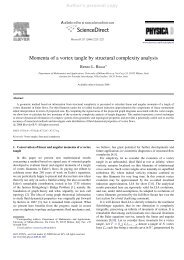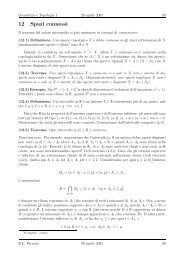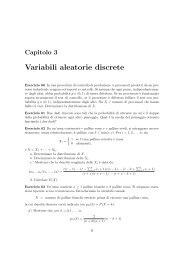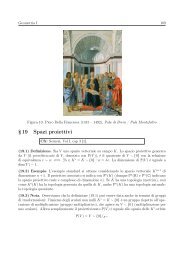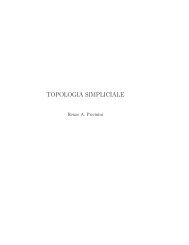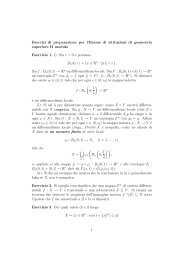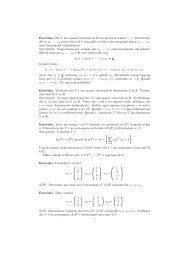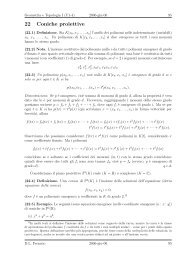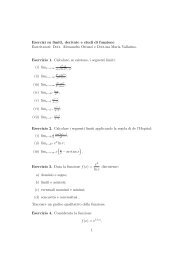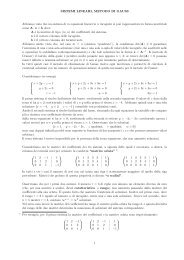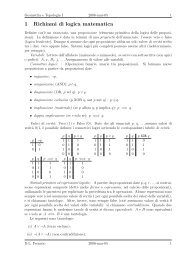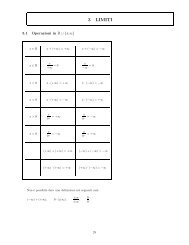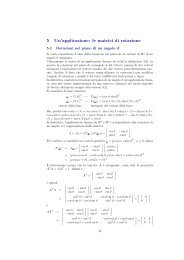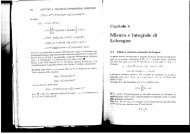Sezione F7 Meccanica del continuo
Sezione F7 Meccanica del continuo
Sezione F7 Meccanica del continuo
Create successful ePaper yourself
Turn your PDF publications into a flip-book with our unique Google optimized e-Paper software.
<strong>Sezione</strong> <strong>F7</strong><br />
<strong>Meccanica</strong> <strong>del</strong> <strong>continuo</strong><br />
D. Ambrosi, <strong>Meccanica</strong> <strong>del</strong>la crescita: continui monocomponente e miscele<br />
D. Bambusi, Metodi di forma normale in equazione a derivate parziali<br />
I. Barbieri, Fenomeni ondulatori in biologia<br />
V. Berti, Risultati di esistenza e unicità per un’equazione integro-differenziale con nucleo<br />
di memoria singolare<br />
S. Carillo, Minimum free energy in heat condition: materials with memory<br />
C. Cattani, Cubic nonlinear waves in elastic materials<br />
G. Caviglia, Riflessione e trasmissione in solidi anisotropi stratificati: esistenza e unicità<br />
P. Cermelli, Renormalized energy and forces on dislocations<br />
A. Lovinson, Funzioni generatrici globali a finiti parametri in teoria dei campi<br />
F. Mainardi, Risultati recenti per l’equazione <strong>del</strong>la diffusione frazionaria<br />
P. M. Mariano, Hamiltonian structures in multifield theories of complex materials<br />
M. S. Mongiovì, Su un mo<strong>del</strong>lo macroscopico <strong>del</strong>la turbolenza quantistica<br />
M. G. Naso, Controllo <strong>del</strong>le vibrazioni in una piastra termoelastica mediante sorgenti<br />
di calore<br />
M. Padula, Lyapunov method applied to nonlinear hyperelastic and linearly viscous<br />
bodies<br />
L. Palese, A linear magnetic Benard problem with hall and ion-slip effects<br />
F. Pastrone, Non linear waves in approximately constrained materials<br />
S. Polidoro, Decadimento esponenziale per le equazioni di Maxwell con memoria al<br />
bordo<br />
L. Restuccia, Material forces in inhomogeneous ferroelectric crystals<br />
E. Scarpetta, Analytical results for scattering problems in wave propagation<br />
G. Tomassetti, Equazioni di evoluzione di una parete di dominio in un corpo ferromagnetico<br />
indeformabile
XVII Congresso U.M.I.<br />
Milano, 8-13 settembre 2003<br />
<strong>Meccanica</strong> <strong>del</strong>la crescita: continui<br />
monocomponente e miscele<br />
D. Ambrosi, A. Farina, L. Fusi<br />
Dipartimento di Matematica “U. Dini”, Università degli Studi di Firenze<br />
I tessuti biologici sono caratterizzato dal fatto che crescono, aumentano e diminuiscono<br />
continuamente la loro massa. La crescita dei tessuti molli non e’ di tipo superficiale,<br />
come avviene per le ossa, ma volumetrico. Diverse recenti osservazioni sperimentali hanno<br />
mostrato che questa dipende in modo complesso dallo sollecitazioni meccaniche a cui e’<br />
sottoposto il materiale. Una descrizione matematica <strong>del</strong>la loro meccanica raramente puó<br />
prescindere da una conoscenza <strong>del</strong>la loro dinamica di crescita.<br />
Da un punto di vista matematico questa fenomenologia è un caso particolare <strong>del</strong>la <strong>del</strong><br />
problema di mo<strong>del</strong>lizzare la crescita di un mezzo <strong>continuo</strong>. In questa comunicazione si<br />
discuterà l’efficacia di una decomposizione moltiplicativa <strong>del</strong> gradiente di deformazione<br />
in due contributi, uno che renda conto <strong>del</strong>la crescita, l’altro che descriva le proprietà<br />
meccaniche <strong>del</strong> corpo. In particolare, verranno discussi i legami tra gradiente di crescita<br />
e tasso di crescita, il ruolo <strong>del</strong>l’equazione di bilancio <strong>del</strong>l’energia e la possibilità di trarre<br />
restrizioni sulle relazioni costitutive a partire da opportuni principi. La teoria sviluppata<br />
nel caso monocomponente può essere estesa a miscele in cui una <strong>del</strong>le due componenti<br />
sia un solido elastico. Si mostreranno infine alcuni risultati numerici di simulazioni in<br />
geometrie semplici.<br />
Corso Duca degli Abruzzi 24, 10129 Torino.<br />
E-mail address: ambrosi@calvino.polito.it<br />
Viale Morgagni 67/A, 50134 Firenze, Italy<br />
E-mail address: angiolo.farina@math.unifi.it, fusi@math.unifi.it<br />
1991 Mathematics Subject Classification. Classificazione AMS.<br />
Questa ricerca è stata parzialmente finanziata dall’INDAM-GNFM.
XVII Congresso U.M.I.<br />
Milano, 8-13 settembre 2003<br />
Metodi di forma normale in<br />
equazione a derivate parziali<br />
Dario Bambusi<br />
Dipartimento di Matematica, Universita’ degli studi di Milano<br />
Si intende esporre una recente generalizzazione <strong>del</strong>la teoria <strong>del</strong>le forme normali a equazioni<br />
a derivate parziali iperboliche, mettendo in evidenza come essa permetta di descrivere<br />
qualitativamente le soluzioni di tali equazioni. Si metteranno in evidenza importanti differenze<br />
tra il caso semilineare e quasilineare. Ci si propone di illustrare anche alcune<br />
applicazioni a MHD e altri mo<strong>del</strong>li descriventi la dinamica di corpi continui.<br />
Via Saldini 50, 20133 Milano<br />
E-mail address: Bambusi@mat.unimi.it<br />
1991 Mathematics Subject Classification. 37K55.<br />
Il lavoro è stato parzialmente finanziato dal MIUR, Progetto COFIN2001 “Dinamica dei sistemi classici<br />
Hamiltoniani, fondamenti dinamici <strong>del</strong>la meccanica statistica e dinamica <strong>del</strong>l’interazione radiazione<br />
materia”
XVII Congresso U.M.I.<br />
Milano, 8-13 settembre 2003<br />
FENOMENI ONDULATORI IN BIOLOGIA<br />
I. Barbieri ∗ , L. Colì ◦ , F. Melloni ∗ , G. Pallotti ◦ , P. Pettazzoni ◦ , S. Stefoni ◦<br />
Università di Bologna “Alma Mater Studiorum”,<br />
∗ Facoltà di Scienze MM.FF.NN. – ◦ Facoltà di Medicina e Chirurgia<br />
I fenomeni periodici regolano il mondo <strong>del</strong>la Biologia, in primo luogo il corpo umano<br />
sviluppa nel suo interno fenomeni costantemente ondulatori.<br />
I periodi che si presentano variano in funzione di quelle che sono le attività che debbono<br />
essere svolte e dei diversi organi deputati ad esse; ogni cellula <strong>del</strong> nostro corpo ha un suo<br />
processo armonico che svolge e quindi quando viene generata nasce con una sua particolare<br />
caratteristica di funzione periodica.<br />
In questo lavoro saranno presentati quelli che sono i problemi <strong>del</strong>l’onda sfigmica e <strong>del</strong>la<br />
biomeccanica ad essi connessi.<br />
Il cuore genera l’onda sfigmica dando con ciò origine ad un’oscillazione forzata, necessaria<br />
per far scorrere il sangue in tutto il circuito cardiovascolare e quindi ossigenare i<br />
tessuti per permettere la loro sopravvivenza.<br />
I fenomeni di trasmissione <strong>del</strong>l’onda sfigmica nel corpo umano sono retti dalle leggi che<br />
furono messe in evidenza da Max Anliker che rilevò inoltre l’importanza che rivestono i<br />
tessuti molli <strong>del</strong>l’intera struttura umana.<br />
Oltre a quella che è l’esposizione <strong>del</strong> processo dal punto di vista teorico, verrà considerato<br />
anche l’effetto che viene ad aversi a livello pratico e clinico.<br />
E-mail address: barbieri@dm.unibo.it, pallotti@DF.UNIBO.IT
XVII Congresso U.M.I.<br />
Milano, 8-13 settembre 2003<br />
Risultati di esistenza e unicità per un’equazione<br />
integro-differenziale con nucleo di memoria singolare<br />
Valeria Berti<br />
Università di Bologna<br />
L’evoluzione di un solido viscoelastico lineare è descritta dall’equazione differenziale<br />
(1) ü(x, t) = ∇ · T (x, t) + f(x, t),<br />
in cui il tensore degli sforzi T soddisfa l’equazione costitutiva<br />
T (x, t) = G ∞ (x)∇u(x, t) −<br />
∫ ∞<br />
0<br />
G ′ (x, s)[∇u(x, t) − ∇u(x, t − s)]ds ,<br />
Nelle trattazioni classiche, si assume che il nucleo di memoria G ′ sia una funzione L 1 <strong>del</strong><br />
tempo. Tuttavia il comportamento di alcuni materiali viscoelastici può essere descritto da<br />
un mo<strong>del</strong>lo in cui il nucleo presenta una singolarità iniziale.<br />
In questa presentazione verrà considerato il caso in cui G ′ /∈ L 1 , ma una sua primitiva<br />
sia integrabile nell’origine.<br />
La ricerca <strong>del</strong>le soluzioni deboli <strong>del</strong>l’equazione (1) porta all’introduzione di uno spazio<br />
funzionale dipendente esplicitamente dalle proprietà <strong>del</strong> nucleo di memoria. Sotto opportune<br />
ipotesi di regolarità <strong>del</strong>le sorgenti, si dimostra un teorema di esistenza e unicità<br />
<strong>del</strong>la soluzione <strong>del</strong> problema evolutivo. Tale risultato è ottenuto utilizzando il metodo <strong>del</strong>la<br />
trasformata di Fourier per ricercare le soluzioni nel dominio <strong>del</strong>le frequenze e riconducendo<br />
il sistema integro-differenziale originario alla determinazione <strong>del</strong>le soluzioni di un problema<br />
ellittico con frequenza fissata.<br />
Dipartimento di Matematica, P.zza Porta San Donato 5, 40126 Bologna.<br />
E-mail address: berti@dm.unibo.it<br />
1991 Mathematics Subject Classification. Classificazione AMS: 74D05, 74H20, 74H25.
Minimum free energy in heat conduction:<br />
materials with memory 1<br />
Sandra Carillo<br />
Dipartimento di Metodi e Mo<strong>del</strong>li Matematici per le Scienze Applicate, Università di<br />
Roma “La Sapienza”, I-00161 Rome, Italy<br />
The minimum free energy is obtained in the cases of a rigid linear heat conductor with<br />
memory. Thus, the result is compared with results concerning the minimum free energy<br />
in isothermal viscoelasticity. Interesting similarities can be observed when such results<br />
are compared. In addition, in both the cases, the minimum free energy is related to<br />
the maximum recoverable work. The mo<strong>del</strong> of rigid heat conductor here adopted is that<br />
one comprised in Fabrizio, Gentili and Reynolds [3] where the thermodynamics of a rigid<br />
omogeneous linear heat conductor with memory is studied. The results concerning the<br />
minimum free energy in this framework have been recently studied [1]; they are compared<br />
with results in the study of isothermal viscoelasticity. In particular, results here referred<br />
to have been obtained by Fabrizio and Golden [4], Fabrizio, Deseri, Gentili and Golden<br />
[2], Golden [6], Gentili [5], where, in addition, historical notes as well as many references<br />
on the study of isothermal viscoelasticity are comprised.<br />
E-mail address: carillo@dmmm.uniroma1.it<br />
References<br />
[1] S. Carillo: A rigid linear heat conductor with memory: minimum free energy, preprint<br />
Dipartimento di Metodi e Mo<strong>del</strong>li Matematici, Universita‘ di Roma “La Sapienza”,<br />
2003.<br />
[2] L. Deseri, G. Gentili, J.M. Golden: An Explicit Formula for the Minimum Free Energies<br />
in Linear Viscoelasticity, J. Elasticity, 54, p. 141-185, 1999.<br />
[3] M. Fabrizio, G. Gentili, D.W.Reynolds: On rigid heat conductors with memory, Int.<br />
J. Eng. Sci. , 36, p. 765–782, 1998.<br />
[4] M. Fabrizio, J.M. Golden: Maximum and minimum free energies for a linear viscoelastic<br />
material, Quart. Appl. Math., 60, no. 2, p. 341–381, 2002.<br />
[5] G. Gentili: Maximum recoverable work, minimum free energy and state space in linear<br />
viscoelasticity, Quart. Appl. Math., 60, no. 1, p. 153–182, 2002.<br />
[6] J. M. Golden: Free energies in the frequency domain: the scalar case, Quart. Appl.<br />
Math., 58, p. 121–150, 2000.<br />
1<br />
Classificazione AMS 80A20, 74F05<br />
Under the support of G.N.F.M.-I.N.D.A.M. and of M.I.U.R., Progetto Cofinanziato 2002 Mo<strong>del</strong>li Matematici<br />
per la Scienza dei Materiali<br />
1
XVII Congresso U.M.I.<br />
Milano, 8-13 settembre 2003<br />
Cubic Nonlinear Waves in Elastic Materials<br />
Carlo Cattani<br />
Università di Roma “La Sapienza”,<br />
Sunto The lecture is devoted to cubic nonlinearity of hyperelastic waves in materials and deals with: 1)<br />
Cubic nonlinear wave equations for hyperelastic plane waves in materials; 2) Third harmonics generation<br />
by initially excited harmonic longitudinal wave; 3) New simple waves generation by initially excited simple<br />
longitudinal wave. Especial attention is payed to simple waves and similarity between new harmonic and<br />
simple waves generation. Some peculiarities of using the wavelets analysis to revealed wave effects are<br />
discussed.<br />
It is shown that cubic nonlinearity and nonlinearities of higher order follow naturally from classical<br />
nonlinear acoustics approach and should be considered equally important compared with the quadratic<br />
nonlinearity. Cubic non-linearity is wi<strong>del</strong>y discovered and investigated<br />
surface waves in fluids.<br />
in the theory of internal and<br />
Nonlinear deformations are realized in classical theory using the Murnaghan elastic potential<br />
W (ɛ ik) ) = 1 2 λ(ɛ mm) 2 + µ(ɛ ik ) 2 +<br />
+ 1 3 Aɛ ikɛ im ɛ km + B(ɛ ik ) 2 ɛ mm + 1 3 C(ɛ mm) 3 . (1)<br />
Here λ, µ are Lame elastic constants, A, B, C are Murnaghan elastic constants, ɛ ik = 1 2 (u i,k + u k,i +<br />
u m,i u m,k ) is the nonlinear Green strain tensor.<br />
The Murnaghan potential describes a broad class of materials, is basic in mechanics of materials and<br />
wi<strong>del</strong>y used. The Murnaghan representation, usually noted as cubic, relatively to the strain tensor is<br />
W quad = 1 (<br />
2 λ( ) 2 1<br />
u m,m +<br />
4 µ( ) 2<br />
u i,k + u k,i + µ + 1 )u<br />
4 A i,k u m,k u m,i +<br />
+ 1 ( ) ( ) 2 1<br />
λ + B um,m ui,k +<br />
2<br />
12 Au i,ku k,m u m,i +<br />
+ 1 2 Bu i,ku k,i u m,m + 1 3 C( u m,m<br />
) 3. (2)<br />
This form preserves the initial cubic nonlinearity, but already not on the strain tensor. Owing to nonlinearity<br />
of the Green strain tensor, the complete representation of the Murnaghan potential will include<br />
summands from the second to the sixth orders relatively to the gradient. All these terms will be taken<br />
into account, coming into the third and more orders nonlinearities in material deformations.<br />
Dipartimento di Matematica “G.Castelnuovo”,<br />
Università di Roma “La Sapienza”,<br />
P.le A. Moro 5, I-00185 Rome<br />
E-mail address: carlo.cattani@uniroma1.it
XVII Congresso U.M.I.<br />
Milano, 8-13 settembre 2003<br />
Riflessione e trasmissione in solidi anisotropi<br />
stratificati: esistenza e unicità<br />
G. Caviglia e A. Morro<br />
Università di Genova<br />
Si considera uno strato solido di spessore finito, con parametri materiali variabili con<br />
continuità lungo una direzione assegnata n. Lo strato è compreso fra due semispazi (solidi)<br />
omogenei; in generale, i piani di contatto sono superfici di discontinuità dei parametri<br />
materiali. Si suppone che i solidi siano viscoelastici lineari anisotropi. Essendo assegnata<br />
un’onda che incide sullo strato, si esamina il problema <strong>del</strong>la riflessione-trasmissione.<br />
Nel dominio <strong>del</strong>le trasformate di Fourier, si sceglie la dipendenza dalle coordinate<br />
trasversali e dal tempo tipica <strong>del</strong>le onde piane, mo<strong>del</strong>lando così l’effetto di onde incidenti<br />
oblique. In queste ipotesi le equazioni di propagazione sono scritte nella forma di<br />
un sistema di sei equazioni differenziali ordinarie <strong>del</strong> primo ordine, lineari, a coefficienti<br />
complessi, nel quale sono incognite le componenti <strong>del</strong>lo spostamento e <strong>del</strong>la trazione sui<br />
piani ortogonali alla direzione <strong>del</strong>la stratificazione, n.<br />
Si associa ad ogni onda uno scalare, F, che rappresenta il flusso di energia per unità<br />
di tempo e per unità di superficie perpendicolare ad n. Come conseguenza <strong>del</strong> secondo<br />
principio <strong>del</strong>la termodinamica si dimostra che F decresce durante la propagazione nel caso<br />
di solido viscoelastico e che si mantiene costante nel caso di solido elastico. Si dimostra<br />
inoltre che F è generato da una matrice hermitiana Φ avente tre autovalori positivi e<br />
tre autovalori negativi. Mediante gli autovettori di Φ associati agli autovalori positivi<br />
(negativi) si definiscono i tre generatori <strong>del</strong>le onde che si propagano in avanti (all’indietro)<br />
rispetto al verso di n, essendo inteso che il verso di propagazione di un’onda è determinato<br />
dal segno <strong>del</strong> corrispondente flusso di energia F.<br />
Rappresentando in termini di generatori le onde incidente (assegnata), riflessa (incognita)<br />
e trasmessa (incognita) e sfruttando la proprietà <strong>del</strong> flusso F si dimostra un teorema<br />
di esistenza e unicità per il problema <strong>del</strong>le riflessione e trasmissione.<br />
E-mail address: caviglia@dima.unige.it<br />
1991 Mathematics Subject Classification. Classificazione AMS: 74J20, 74D05.<br />
La ricerca che ha condotto a questo lavoro è stata svolta nell’ambito <strong>del</strong> Progetto di Ricerca COFIN<br />
2002 “Mo<strong>del</strong>li Matematici per la Scienza dei Materiali” <strong>del</strong> MIUR.
XVII Congresso U.M.I.<br />
Milano, 8-13 settembre 2003<br />
Renormalized energy and forces on dislocations<br />
Paolo Cermelli ∗ and Giovanni Leoni ∗∗<br />
(∗) Dipartimento di Matematica, Universita’ di Torino, (∗∗)<br />
Department of Mathematical Sciences, Carnegie-Mellon University.<br />
The goal of this work is to give a variational formulation of the equilibrium problem for<br />
a finite number of screw dislocations in a cylindrical domain, give a representation of the<br />
renormalized energy and discuss its relation with the configurational forces (the Peach-<br />
Köhler force) on the dislocations. The results obtained in this paper may provide the basis<br />
to study the relations between discrete and continuum theories of dislocations, in order to<br />
characterize ’ab initio’ the macroscopic constitutive relations of defective materials.<br />
(∗) Via C. Alberto 10, 10123 Torino, Italy, (∗∗) Pittsburgh, PA 15213, USA<br />
E-mail address: (∗) paolo.cermelli@unito.it, (∗∗) leoni@math.cmu.edu<br />
1991 Mathematics Subject Classification. 74-xx, 49-xx.<br />
Progetto Cofin 2002: ”Mo<strong>del</strong>li Matematici per la Scienza dei Materiali” .
XVII Congresso U.M.I.<br />
Milano, 8-13 settembre 2003<br />
Funzioni generatrici globali<br />
a finiti parametri<br />
in teoria dei campi<br />
Alberto Lovison<br />
Dipartimento di Matematica Pura ed Applicata<br />
Consideriamo il principio variazionale di Volterra-Vainberg per un problema quasi lineare<br />
con condizioni al bordo di Dirichlet:<br />
{ N(u) = Lu − εF (u) = 0 in Ω<br />
u| ∂Ω = 0<br />
⇐⇒<br />
dJ(u) = 0, J(u) =<br />
∫ 1<br />
0<br />
u critico per<br />
〈N(tu), u〉 dt,<br />
dove L è un operatore ellittico, F un operatore non lineare limitato, ε è un (piccolo)<br />
parametro. Se la perturbazione F (u) ha inoltre derivata limitata, allora, grazie alla decomposizione<br />
spettrale <strong>del</strong>l’operatore L ed a una tecnica di punto fisso, consistente sostanzialmente<br />
in una versione spettrale —introdotta in [1]— <strong>del</strong>la riduzione finito-dimensionale<br />
di Amann-Conley-Zehnder —c.f. [2]—, possiamo scrivere un nuovo equivalente principio<br />
variazionale dW (µ 1 , . . . , µ m ) = 0, dove ora W (µ 1 , . . . , µ m ) dipende soltanto da m<br />
parametri reali. Condizioni di limitatezza su F assicurano l’esistenza di soluzioni u sulla<br />
base di considerazioni topologiche. La teoria si configura utile per esempio in problemi di<br />
Elasto-Statica.<br />
[1] F. Cardin, Global Finite Generating Functions for Field Theory, Banach Center Publications,<br />
Vol. 59, 2002.<br />
[2] C. Viterbo, Recent progress in periodic orbits of autonomous Hamiltonian systems and<br />
applications to symplectic geometry. Nonlinear functional analysis (Newark, NJ, 1987),<br />
227–250, Lecture Notes in Pure and Appl. Math., 121, Dekker, New York, 1990.<br />
Via Belzoni, 7 - 35131 Padova<br />
E-mail address: lovison@math.unipd.it<br />
1991 Mathematics Subject Classification. Classificazione AMS.
XVII Congresso U.M.I.<br />
Milano, 8-13 settembre 2003<br />
Risultati recenti per<br />
l’equazione <strong>del</strong>la diffusione frazionaria<br />
Francesco MAINARDI, Gianni PAGNINI, Alesandro VIVOLI<br />
Dipartimento di Fisica <strong>del</strong>l’Università di Bologna<br />
Si analizzano i recenti risultati ottenuti dal nostro gruppo di ricerca sui processi diffusivi<br />
anomali governati da equazioni di evoluzione integro-differenziali i cui operatori si<br />
interpretano come derivate spazio-temporali frazionarie (cioè di ordine non intero). In particolare<br />
si derivano le soluzioni fondamentali in termini di funzioni speciali appartenenti<br />
alla classe generale <strong>del</strong>le funzioni H . Tali funzioni furono introdotte negli anni ’60 da Fox<br />
mediante i cosidetti integrali di Mellin-Barnes nel campo complesso. Tali soluzioni si possono<br />
interpretare come densità spaziali di probabilità che si evolvono nel tempo, relative<br />
a processi stocastici non-Gaussiani e non-Markoviani. Mediante il metodo <strong>del</strong>le differenze<br />
finite usato per approssimare le derivate frazionarie si forniscono mo<strong>del</strong>li discreti e continui<br />
di ”random walk” che forniscono una descrizione adeguata di questi processi stocastici.<br />
Via Irnerio 46, 40126 BOLOGNA<br />
E-mail address: francesco.mainardi@unibo.it<br />
Via Gobetti 101, 40129 Bologna<br />
E-mail address: g.pagnini@isac.cnr.it<br />
Via Irnerio 46, 40126 BOLOGNA<br />
E-mail address: alessandro.vivoli@studio.unibo.it<br />
1991 Mathematics Subject Classification. 26A33, 33C60, 45K05, 60G18, 60G50, 60G55, 60J60..<br />
This work is partially supported by GNFM-INDAM
Hamiltonian structures in multifield theories of complex<br />
materials<br />
Gianfranco Capriz and Paolo Maria Mariano<br />
Preliminary results toward the analysis of the Hamiltonian structure of multifield<br />
theories describing complex materials are mustered: we involve the invariance<br />
under the action of a general Lie group of the balance of substructural interactions.<br />
Poisson brackets are also introduced in the material representation to account for<br />
general material substructures described by coarse-grained order parameters belonging<br />
to a paracompact differentiable manifold without boundary.<br />
A Hamilton-Jacobi equation suitable for multifield mo<strong>del</strong>s is presented.<br />
Finally, a spatial version of all these topics is discussed without making use of<br />
the notion of paragon setting, involving strictly only the current spatial metric.<br />
Università di Pisa, Dipartimento di Matematica, via F. Buonarroti 2, I-56127 Pisa<br />
E-mail address: capriz@dm.unipi.it<br />
Current address: Università di Roma ”La Sapienza”, Dipartimento di Ingegneria Strutturale<br />
e Geotecnica, via Eudossiana 18, I-00184 Roma<br />
E-mail address: paolo.mariano@uniroma1.it<br />
1991 Mathematics Subject Classification. 74A30; 74N15; 74B99.<br />
1
XVII Congresso U.M.I.<br />
Milano, 8-13 settembre 2003<br />
SU UN MODELLO MACROSCOPICO<br />
DELLA TURBOLENZA QUANTISTICA<br />
Maria Stella Mongiovì<br />
Dipartimento di Matematica ed Applicazioni, Università di Palermo<br />
In questo lavoro, utilizzando i metodi <strong>del</strong>la termodinamica di non equilibrio, si formula<br />
un mo<strong>del</strong>lo macroscopico <strong>del</strong>la turbolenza superfluida. In particolare, proseguendo uno<br />
studio già iniziato, si ampliare un precedente mo<strong>del</strong>lo termodinamico monofluido <strong>del</strong>l’elio II<br />
liquido [1-8], volto essenzialmente alla descrizione di flussi laminari, allo scopo di studiarne<br />
il comportamento in presenza di turbolenza, anche in riferimenti non inerziali. Gli effetti<br />
macroscopici <strong>del</strong> groviglio di vortici sono descritti mediante l’introduzione di un tensore,<br />
caratterizzante la turbolenza quantistica.<br />
Tale mo<strong>del</strong>lo prende in considerazione come campi fondamentali la densità, la temperatura,<br />
la velocità, il flusso di calore ed il contributo al tensore pressione dovuto alla<br />
presenza dei vortici. Le equazioni di evoluzione per questi campi sono dedotte utilizzando<br />
i metodi <strong>del</strong>la termodinamica estesa ed applicate allo studio <strong>del</strong>la turbolenza quantistica.<br />
In particolare, nel lavoro verrà analizzata l’evoluzione <strong>del</strong>la struttura <strong>del</strong> groviglio di<br />
vortici in canali di varia forma e dimensione in presenza di flussi sia di materia che di calore<br />
(counterflow and coflow), e l’influenza <strong>del</strong>la rotazione sulla struttura e sull’evoluzione <strong>del</strong><br />
groviglio di vortici. Ciò verrà fatto studiando l’effetto <strong>del</strong>la presenza <strong>del</strong> groviglio di vortici<br />
sulla propagazione <strong>del</strong>l’onda termica.<br />
Bibliografia<br />
[1] Mongiovì M.S. J. Non Equilibrium Thermodyn., Vol.16, (1991), 225-239<br />
[2] Mongiovì, M.S., Phys. Rev. B, 48, N 0 9, 6276-6283, (1993)<br />
[3] Mongiovì, M.S., Romeo, S., J. Non-Equilib. Thermodyn., 20, (1995), 39-49<br />
[4] Mongiovì, M.S., Romeo, S., Z.A.M.P., 47, (1996), pp. 144-161.<br />
[5] Mongiovì, M.S., Physica A, 292, 1-4, (2001), 55-74.<br />
[6] Mongiovì, M.S., Phys. Rev. B, 63, (2001), 12501, (4 pages).<br />
[7] Jou, D., Lebon, G., Mongiovì, M.S., ”Phys. Rev. B, 66, (2002), 224509, (9 pages).<br />
[8] Mongiovì, M.S., Peruzza, R.A., Zangew. Math. Phys. 54, (4), (2003), 1-18<br />
c/o Facoltà di Ingegneria, Viale <strong>del</strong>le Scienze, I-90128 Palermo, Italy<br />
E-mail address: mongiovi@unipa.it<br />
1991 Mathematics Subject Classification. Classificazione AMS 82D50, 76F99.<br />
Lavoro svolto con i contributi <strong>del</strong> MIUR, fondi 60%
XVII Congresso U.M.I.<br />
Milano, 8-13 settembre 2003<br />
Controllo <strong>del</strong>le vibrazioni in una piastra termoelastica<br />
mediante sorgenti di calore.<br />
Maria Grazia Naso<br />
Dipartimento di Matematica, Università degli Studi di Brescia<br />
Presentiamo alcuni risultati sul controllo, in un dato istante T > 0, <strong>del</strong>la soluzione (u, θ)<br />
per la piastra termoelastica di tipo Eulero-Bernoulli<br />
⎧<br />
u tt + ∆ ⎪⎨<br />
2 u + ∆θ = 0 , θ t − ∆θ − ∆u t = χ ω f in Ω × (0, T )<br />
u = 0, ∆u = 0, θ = 0 su ∂Ω × (0, T ) (1)<br />
⎪⎩<br />
u(0) = u 0 , u t (0) = u 1 , θ(0) = θ 0<br />
in Ω<br />
dove Ω è un sottoinsieme aperto, connesso e limitato di R 2 , con bordo ∂Ω, ω un qualsiasi<br />
sottoinsieme aperto di Ω, χ ω è la funzione caratteristica di ω, e u 0 , u 1 , θ 0 sono i dati iniziali<br />
in un opportuno spazio. Posto v := u t , introdotto H := ( H 2 (Ω) ∩ H 1 0 (Ω)) ×L 2 (Ω)×L 2 (Ω),<br />
con [û 0 , û 1 , ˆθ 0 ] ∈ H e ˆf ∈ L 2 (ω × (0, T )), sia ẑ(T ) := [û(T ), ˆv(T ), ˆθ(T )] la soluzione <strong>del</strong><br />
sistema (1) nell’istante T > 0. Scelta poi un’altra terna di dati iniziali [ũ 0 , ũ 1 , ˜θ 0 ] ∈ H,<br />
vogliamo determinare se esista un controllo ˜f ∈ L 2 (ω × (0, T )) tale che la soluzione ˜z(T ),<br />
associata al sistema, sia uguale a ẑ(T ), nello stesso istante T (controllo <strong>del</strong>le traiettorie).<br />
Il problema può essere risolto considerando il sistema (1) con z 0 := ẑ 0 − ˜z 0 , f := ˆf − ˜f e<br />
cercando un controllo f ∈ L 2 (ω × (0, T )) in modo tale che lo stato iniziale z 0 possa essere<br />
trasferito allo stato nullo, nell’istante T (controllabilità nulla).<br />
Illustriamo quindi i risultati teorici [BN] e numerici [GN], determinati in particolare<br />
quando ω ⊂ Ω. Applicando un metodo iterativo e stime di osservabilità, proviamo che il<br />
mo<strong>del</strong>lo è controllabile a zero, in un qualsiasi istante T > 0 mediante controlli termici di<br />
tipo L 2 (ω × (0, T )).<br />
Bibliografia<br />
[BN] A. Benabdallah, M.G. Naso, Null controllability of a thermoelastic plate, Abstr. Appl. Anal. 7 (2002), no. 11,<br />
585–599.<br />
[GN] P. Gervasio, M.G. Naso, Numerical approximations of the controllability of trajectories for Euler-Bernoulli thermoelastic<br />
plates, preprint, 2003.<br />
Dipartimento di Matematica, Università degli Studi di Brescia, Via Valotti 9, 25133 Brescia, Italia.<br />
E-mail address: naso@ing.unibs.it<br />
1991 Mathematics Subject Classification. 35B37, 74B05, 93B05.<br />
Questi risultati sono stati ottenuti sotto gli auspici <strong>del</strong> G.N.F.M.–C.N.R. e parzialmente finanziati dal<br />
M.I.U.R. attraverso il Programma di Ricerca 2002 ‘Mo<strong>del</strong>li Matematici per la Scienza dei Materiali’.
Power and incremental work for a thermoelastic body: their<br />
consequences on control of a rest state.<br />
M. Padula, Dept. Mathematics, University of Ferrara, Italy<br />
Abstract<br />
Let C k be the reference configuration of a thermo-elastic body B, and let C ∗ be a rest<br />
state configuration of B. We reach three objectives: i) control in time of perturbations to C ∗<br />
in terms of the data; ii) asymptotic decay to zero, as t → ∞, of perturbations to C ∗, in case<br />
of dissipative systems; iii) nonlinear instability in case of nodissipative mechanical systems.<br />
To not obscure the lines of reasoning, mechanical systems are considered first. The concept<br />
of power is used to construct a Lyapunov functional V correct to furnish stability in the<br />
mean when the total energy E has a minimum at C ∗, then introducing the new concept of<br />
incremental work another functional F is constructed which provides at once asymptotic<br />
stability if E has a minimum at C ∗ and instability if E has a maximum at C ∗. Paper ends<br />
with study of thermo-elastic systems, where a different energy H is introduced, it remembers<br />
the Helmohltz free energy. Stability in the mean is proven, for nondissipative systems, when<br />
the basic temperature is uniform, furthermore, asymptotic stability is proven in case the basic<br />
temperature gradient is not to large.<br />
Stability in the mean for hyperelastic, or thermo-elastic continua, is proved under the<br />
assumtpion that the basic configuration is a local minimum for a suitable energy E(S). To<br />
this end, we employ the difference between the balance equations of power, valid for the<br />
motion C t, and for the rest C ∗. In this way, the Lyapunov functional is the difference between<br />
the energy E in the states C t and C ∗, that is V = E(C t) − E(C ∗), the viscous dissipative<br />
term can be zero. Next, we analize the same continua when the viscous dissipative term<br />
is not zero. In this case, the time derivative of E(C t) − E(C ∗) is strictly negative, and a<br />
decay of the motion to the rest is expected in the general theory. Multiplying the momentum<br />
equation times the displacement vector joining x ∈ C t to x ∗ ∈ C ∗, and then integrating<br />
over C t, we obtain a fictious energy V 1 that must be added to V. The stability in the mean<br />
may be achieved for general boundary conditions: displacement and traction problem. The<br />
asymptotic result is achieved for displacement problem. We confine ourselves to displacement<br />
problem at boundary.<br />
1
A LINEAR MAGNETIC BÉNARD PROBLEM WITH HALL AND ION-SLIP EFFECTS<br />
L. Palese<br />
University Campus, Mathematics Department, Bari, Italia.<br />
A.Georgescu<br />
University of Pitesti, Faculty of Mathematics and Computer Science, Pitesti, Romania.<br />
For normal mode perturbations, in the hypothesis that the principle of exchange of<br />
stabilities holds, the eigenvalue problems defining the neutral curves of the linear stability<br />
for some magnetic electroanisotropic Bénard problem are solved by Budiansky-DiPrima<br />
method. The unknown functions are taken as Fourier series on some total sets of separable<br />
Hilbert spaces and the expansion functions satisfied only part of the boundary conditions<br />
of the problem. This introduces some constraints to be satisfied by the Fourier coefficients.<br />
In order to keep the number of these constraints as low as possible we are lead to use total<br />
sets for the even velocity and temperature fields different from the case when velocity<br />
and temperature are odd.The splitting of the unknown functions into even and odd parts<br />
leads to two problems of the same order as the given one each of which containing even<br />
as well as odd order parts of these functions. The secular equations involve series which<br />
are truncated to one and two terms, the last situation corresponding to best results. A<br />
closed form of the neutral curve is obtained. The presence of the Hall and ion-slip currents<br />
is proved to be destabilizing. We recover the destabilizing effect of the Hall current and,<br />
in the case when the Hall effect is absent, we prove that the singularities ot the secular<br />
equation are eigenvalues of the given boundary value problem. In other words, the smallest<br />
singular value of the secular equation defines the neutral curve of the linear instability.<br />
1
XVII Congresso U.M.I.<br />
Milano, 8-13 settembre 2003<br />
Non Linear Waves in Approximately<br />
Constrained Materials<br />
Franco Pastrone and Maria Luisa Tonon<br />
Dipartimento di Matematica. Universita’ di Torino<br />
A first definition of approximately constrained bodies is due to G. Grioli and it is based<br />
on the idea that we can choose in the constitutive equations of a hyperelastic material an<br />
appropriate structural parameter such that the body becomes rigid when the parameter<br />
tends to infinity.<br />
This idea was refined by S. Marzano and P. Podio Guidugli, who used a Signorini-type<br />
perturbative scheme based on constitutive equations exhibiting a pole of some order: for<br />
example, a first order pole defines an approximately constrained material if at the first<br />
order of approximation the displacement gradient is constrained.<br />
Similar problems has been faced by G. A. Rogerson and N. H. Scott, with a different<br />
terminology (nearly-constrained materials).<br />
Recently, F. Pastrone and M.L. Tonon, L. Bortoloni and F. Pastrone proposed a general<br />
treatment of the propagation of non linear acceleration waves in approximately constrained<br />
materials with first and second order poles.<br />
Explicit results for speeds and amplitudes can be obtained in some particular cases, like<br />
St. Venant- Kirchhoff materials, which can be used to approximate rigid or incompressible<br />
bodies, according to the different choices for the singular term in the constitutive equations;<br />
the same occurs for isotropic hyperelastic materials.<br />
The use of a suitable ray method allows us to determine propagation speeds and evolution<br />
equations for isotropic and anisotropic materials; hence we can apply this method<br />
to unidirectionally fibre-reinforced materials, with the constraint that the fibre is almost<br />
inextensible or almost rigid. It is proved that we can have only waves propagating along<br />
the fibres.<br />
Finally, we study the propagation of waves in approximately inextensible bodies (in<br />
some preferred direction), which include the previous case, as an example of materials<br />
with a second order pole. Many real materials exhibit such a behaviour, characterized by<br />
a strong anisotropy and mechanical properties which are highly dependent on a preferred<br />
direction in the material.<br />
Via Carlo Alberto 10, 10123 Torino<br />
E-mail address: franco.pastrone@unito.it<br />
1991 Mathematics Subject Classification. 74J30.<br />
Progetto COFIN 2002: Mo<strong>del</strong>li matematici in scienza dei materiali
XVII Congresso U.M.I.<br />
Milano, 8-13 settembre 2003<br />
Decadimento esponenziale per le equazioni<br />
di Maxwell con memoria al bordo<br />
R. Nibbi, S. Polidoro<br />
Dipartimento di Matematica, Università di Bologna<br />
L’evoluzione <strong>del</strong> campo elettromagnetico (E, H) in un dielettrico lineare, isotropo ed<br />
omogeneo, in assenza di cariche libere e di sorgenti esterne, è descritta in Q = Ω × R + ,<br />
dove Ω è un dominio sufficientemente regolare d R 3 , dalle equazioni di Maxwell<br />
(1) ε ∂E<br />
∂t − ∇ × H = 0,<br />
µ∂H ∂t<br />
+ ∇ × E = 0, ∇ · E = 0, ∇ · H = 0.<br />
Supponiamo che la frontiera ∂Ω sia realizzata da un “buon conduttore”, in modo tale che<br />
la relazione tra il campo elettrico ed il campo magnetico al bordo sia:<br />
(2) E τ (t) = η 0 H(t) × n +<br />
∫ ∞<br />
0<br />
η(s)H(t − s) × n d s,<br />
dove E τ è la componente tangenziale <strong>del</strong> campo elettrico sul bordo e n rappresenta la<br />
normale esterna al bordo. Nelle ipotesi η ∈ L 1 (R + ) ∩ H 1 (R + ) con η ′ < 0, η ′′ ≥ 0 ed<br />
introdotta la “storia passata integrata” H t (s) = ∫ s<br />
H(t − τ)d τ, la funzione<br />
0<br />
(3) Ψ(t) = 1 ∫<br />
[<br />
ε|E(t)| 2 + µ|H(t)| 2] d x − 1 ∫ ∫ ∞<br />
η ′ (s)|H t (s) × n| 2 d s d σ(x)<br />
2<br />
2<br />
Ω<br />
può essere considerata come energia <strong>del</strong> sistema.<br />
Mediante la teoria dei semigruppi di contrazioni negli spazi di Hilbert, mostriamo che<br />
l’ipotesi che il nucleo di memoria η “decada esponenzialmente” (ossia: esiste una costante<br />
positiva κ per cui η ′′ + κη ′ > 0 in R + ) sia una condizione sufficiente per il decadimento<br />
esponenziale <strong>del</strong>l’energia (3): Ψ(t) ≤ M exp(−µt)Ψ(0), con M e µ costanti positive. Infine<br />
dimostriamo che se la norma <strong>del</strong>la soluzione <strong>del</strong> problema (1)−(2) decade esponenzialmente<br />
(in media), nel senso che esiste una costante α positiva per cui<br />
∫ ∞<br />
( ∫<br />
(<br />
exp(2αt) |Eτ (t)| 2 + |H(t) × n| 2) )<br />
d σ d t < ∞,<br />
0<br />
∂Ω<br />
allora anche il nucleo di memoria η decade esponenzialmente (in media).<br />
P.zza Porta San Donato, 5 - 40126 Bologna<br />
E-mail address: nibbi@dm.unibo.it, polidoro@dm.unibo.it<br />
1991 Mathematics Subject Classification. 35Q60, 74D05, 78A25, 78M35.<br />
∂Ω<br />
0
MATERIAL FORCES INHOMOGENEOUS FERROELECTRIC<br />
CRYSTALS<br />
G. A. Maugin<br />
Loboratoire de Modélization en Mécanique<br />
Université Pierre et Marie Curie<br />
Paris, France<br />
L. Restuccia<br />
University of Messina<br />
Department of Mathematics<br />
Messina, Italy<br />
Abstract<br />
Within the framework of the theory of inhomogeneities ([1]), a systematic construction of the canonical<br />
balance laws of so-called pseudomomentum ([2]) and energy are formulated in the case of thermoelastic<br />
ferroelectrics ([3], [4]). This exploits the notion of material forces on the material manifold. In order to<br />
describe the microstructure of those media the local electric polarization density per unit mass is considered<br />
as an additional degree of freedom which possesses its own dynamics and inertia.<br />
Together with the polarization gradients (describing nonlocal interactions responsible for electric ordering<br />
phenomenologically) it is introduced in the free-energy density.<br />
The canonical form of the energy and pseudomomentum balance plays a crucial role in applications<br />
related to fracture (computation of the so-called energy-release rate and in phase-transition fronts (energy<br />
dissipated at the front).<br />
References<br />
[1] Maugin G.A. (1993), Material inhomogeneities in elasticity, Chapman and Hall, London.<br />
[2] Maugin G.A., Trimarco C. (1992), Pseudomomentum and material forces in nonlinear elasticity: Variational<br />
formulations and application to brittle fracture, Acta Mechanica, 94 1–28.<br />
[3] Maugin G.A., Pouget J. (1980), Electroacoustic equations for one-domain ferroelectric bodies, J. Acoust.<br />
Soc. Am. 68 (2), 575–587.<br />
[4] Maugin G.A., (1988), Continuum Mechanics and Electromagnetic Solids, North-Holland, Amsterdam.<br />
[5] Maugin G.A., (1997), Thermomechanics of inhomogeneous-heterogeneous systems: application to the irreversible<br />
progress of two- and three-dimensional defects. ARI 50, 41–56.<br />
[6] Descalu C.,Maugin G.A., (1994), Energy-release rates and path-independent integrals in electroelastic crack<br />
propagation. Int. J. Engng. Sci. 32, 755–765.<br />
[7] Maugin G.A., Trimarco C., (1997), Driving force on phase transition fronts in thermoelastic crystals.<br />
Mathematics and Mechanics of Solids, 2, 199–214.<br />
1
XVII Congresso U.M.I.<br />
Milano, 8-13 settembre 2003<br />
Analytical results for scattering problems<br />
in wave propagation<br />
Edoardo Scarpetta<br />
Dipartimento di Ingegneria <strong>del</strong>l’Informazione e<br />
Matematica Applicata - Università di Salerno<br />
In the context of wave propagation through damaged (elastic) solids, an analytical<br />
approach to study the normal penetration of a scalar plane wave into a periodic array of<br />
defects with arbitrary shape is developed.<br />
Starting from an integral representation of the wave field and the scattering parameters<br />
already known in the literature for purely numerical treatments, we apply simple (but uniform)<br />
approximations valid in the so-called one-mode regime so as to derive some auxiliary<br />
integral equations independent on frequency.<br />
The problem is thus reduced to a 13×13 (or 22×22) linear system, whose solution leads<br />
to explicit analytical formulas for the above field and parameters.<br />
Numerical resolution of the main integral equations for assigned shapes provide values<br />
for some constants, so that several graphs showing comparison with previous and exact<br />
(numerical) results can be set up.<br />
via Ponte don Melillo, 84084 Fisciano (SA)<br />
E-mail address: scarpett@diima.unisa.it<br />
1991 Mathematics Subject Classification. 73D25.<br />
Questa ricerca è stata svolta nell’ambito <strong>del</strong>le attività <strong>del</strong> Gruppo Nazionale per la Fisica Matematica<br />
<strong>del</strong>l’INdAM
XVII Congresso U.M.I.<br />
Milano, 8-13 settembre 2003<br />
Equazioni di evoluzione di una parete di dominio<br />
in un corpo ferromagnetico indeformabile<br />
Giuseppe Tomassetti<br />
Dipartimento di Ingegneria Civile<br />
Università di Roma “Tor Vergata”<br />
In condizioni di saturazione, un corpo ferromagnetico ci appare suddiviso in regioni in<br />
cui l’orientamento <strong>del</strong> versore magnetizzazione m è costante, i domini magnetici, separate<br />
da sottili regioni di transizione nell’orientamento di m, le pareti di dominio. L’applicazione<br />
di campi magnetici induce un riorientamento <strong>del</strong>la magnetizzazione e, conseguentemente,<br />
la crescita di alcuni domini a scapito di altri.<br />
La dinamica <strong>del</strong>la magnetizzazione in un corpo ferromagnetico indeformabile è descritta<br />
dalla equazione di Gilbert<br />
∂m<br />
∂t + ρ m × ∂m<br />
∂t = m × (<br />
α∆m + 1 ε (m · e)e + h )<br />
,<br />
dove ρ, α ed ε sono costanti positive, il vettore e è l’asse secondo il quale la magnetizzazione<br />
è facile, e h è il campo magnetico.<br />
In questo lavoro vengono ricavate dall’equazione di Gilbert le equazioni di evoluzione<br />
di una parete di dominio, vista come un’interfaccia di fase tra domini confinanti di orientazione<br />
(≡ fase) differente. La parete viene mo<strong>del</strong>lata come una superficie regolare S(t)<br />
che evolve nel tempo così come prescrivono le condizioni di raccordo di due soluzioni <strong>del</strong>la<br />
equazioni di Gilbert, l’una valida in un intorno tubolare di S(t) l’altra nella regione complementare<br />
ad S(t), entrambe ottenute per espansione formale in serie di potenze di ε. Si<br />
trova che, per ε → 0, la parete deve evolvere secondo una equazione di tipo “moto per<br />
curvatura”:<br />
ρ v − σ k = p,<br />
dove v e k sono, rispettivamente, la velocità e la curvatura media <strong>del</strong>la superficie, ρ e σ<br />
sono <strong>del</strong>le costanti positive, e p è un termine forzante dovuto al campo magnetico.<br />
Viale Politecnico snc, 00133 Roma.<br />
E-mail address: tomassetti@ing.uniroma2.it<br />
1991 Mathematics Subject Classification. 35Q60, 41A60.<br />
Ricerca svolta nell’ambito <strong>del</strong> Progetto Cofinanziato 2002 “Mo<strong>del</strong>li Matematici per la Scienza dei<br />
Materiali” e <strong>del</strong> TMR Contract FMRX-CT98-0229 “Phase Transitions in Crystalline Solids”.



